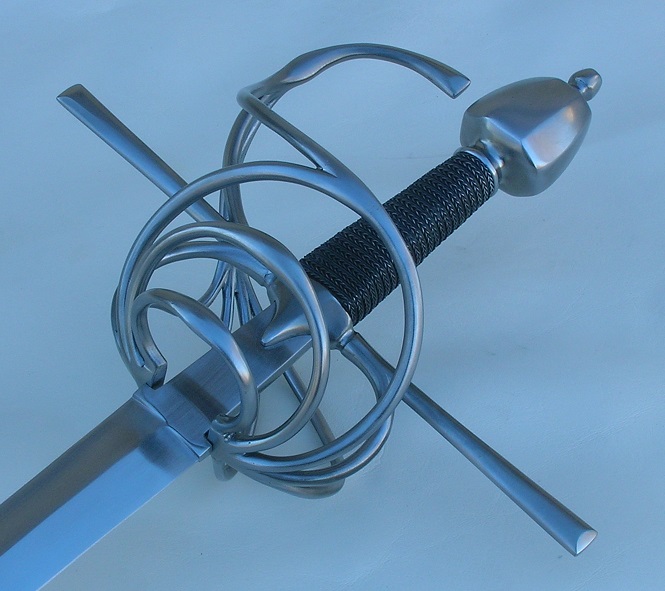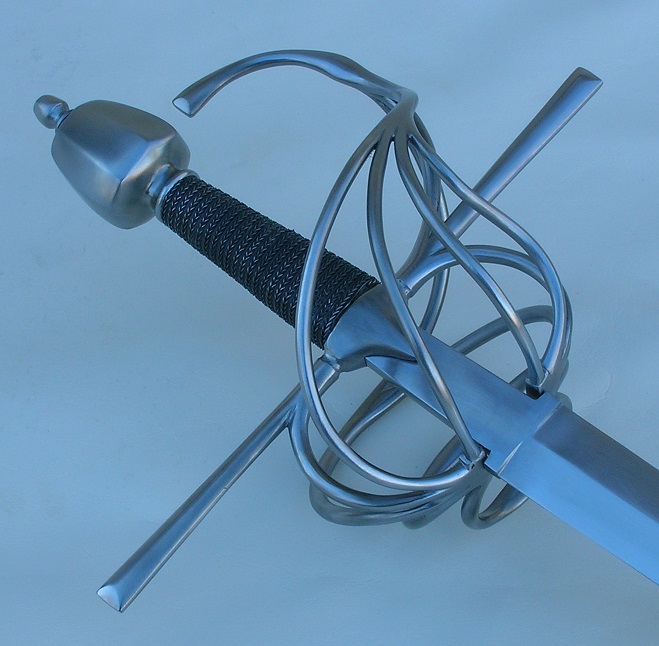A&A Italian Three Ring Rapier
The Italian Three Ring Rapier by Arms and Armor is a pretty typical example of what to expect from this fine company.
In this hands on review we take a look at it from two different perspectives, one of a true Renaissance sword die hard who actually trains in rapier, and the other from a respected SBG member who attempts to see if a rapier can actually cut a tatami mat..!
So read on and enjoy!
A&A Italian Three Ring Rapier Composite Review
Reviewed by Patrick Kelly and SBG member Aikidoka
First look with Patrick Kelly

I've owned quite a few Arms and Armor pieces over the years, especially rapiers. No one else in the production field matches the quality of A&As rapiers. Unless a custom piece is desired there's really no reason to look any further. Incidentally, the companies custom work is also one of their true strong points and one often overlooked by many.
The last A&A rapier to reside in my collection was the Lombardy.
While a nice visually pleasing design, it never did speak to me the way
I'd hoped it would so it was eventually sold. Afterwards I found myself
without a rapier in my collection. I didn't give it a second thought
until I no longer had one, then immediately got the itch to obtain
another. The human mind is a strange thing. :D
For my
next one I chose A&As Italian Three Ring Rapier, but with a slight
alteration. I asked Craig Johnson to mount the sword with the wider
blade of their Two Ring Rapier. Many modern rapiers feature blades just
a bit shorter than they should be so I wanted something a bit longer,
as well as a bit wider than the Three Rings standard blade. A shorter
blade length really alters the feel and handling of the piece and I
wanted something with the correct sense of handling.
Craig readily
agreed to the switch at no extra cost. I was given a delivery window of
twelve weeks. It wound up being almost twice that, and I was
considering a cancellation when I was notified of the swords completion.
So in the end the company came in with the delivery just under the
wire, but without much drama. The sword arrived safely and quite well
packaged. In fact, it was literally a battle just getting it detached
from the box.
I was immediately surprised by the rapiers
feel. With the forty two inch blade I was expecting a much more point
forward feel, with a much greater sense of mass. I was pleasantly
surprised at how lively the weapon feels. Not the feel of a modern
fencing weapon mind you, but quite pleasant and far more responsive than
the aforementioned Lombardy.
I had no trouble running the Italian Three Ring Rapier through movements in the styles of Saviolo, Fabris, etc. However, the blades length is a bit of an impediment when used with the earlier Bolognese styles such as Marrozo. A side sword length blade is obviously preferred for those. All in all though, the Three Ring Rapiers handling was quite a nice surprise.
Examination of the hilt shows a few recent changes. The quillon block now features more detail than the older version of this sword. The inner guard also now exhibits four arms instead of the original three. These are subtle bits of detail that enhance the swords already elegant appearance.

The hilt, as is typical from A&A, comes well finished and assembled.
There are very few casting pits and those that exist are quite small.
The hilt is quite tight and solid, as is the grips wire binding. That
last detail is very cleanly executed as well. Overall I find the
Italian Three Ring Rapier to be a very welcome addition to my collection. It
features a classic hilt design and the blade change proved to be a very
worthwhile decision.
Cutting with Aikidoka

From the time I joined the Phoenix Society of Historical Swordsmanship a couple of years ago, members of the club who study the rapier have asked me whether or not a rapier could cut through a tatami mat. Recently I gave it a try and found that they cut surprisingly well.
The first rapier that I cut a mat with was the Windlass Musketeer
Rapier. It performed well, but I wanted a better quality rapier and one
with a slightly more slender and thicker blade to test what this type of blade could do. The dimensions of the A&A Italian Three-Ring Rapier
were correct for me (quillons at navel height) and I liked the look of
the blade. As luck would have it, Kult of Athena had one in stock so
there was no wait time involved.
I decided to create a new review
for this sword since the review by Patrick Kelly a few years ago was
really for a different sword, since he swapped the stock blade for the
longer wider blade from the A&A Two-Ring Rapier.
Historical Overview
From the A&A website:
"This
slim weapon was quickly embraced by Italian fighters for its agility
and speed. The art of combat with these stiff thrusting blades was quite
deadly. The fully swept hilt protected the hand, a primary target, when
fighting in the streets or a duel. The three side rings on the
foreguard are complimented by a four bar inner guard and a faceted
barrel-shaped pommel. The wire-bound grip allows a firm grip that any
Italian swordman would consider essential. From 1600 to 1640 this type
of rapier was, arguably, the most popular style made. There are many
illustrations in art and surviving examples in museums and collections.
Norman identifies this hilt as Type 61 in his book, The Rapier and the
Smallsword."
The description above reflects the common view that these were mainly thrusting weapons. But the fact is that some Italian masters, Fabris for example, also embraced cutting with rapiers in certain situations and these swords were certainly up to the task.

Statistics
- Blade Length: 40 inches (from the quillons)
- Grip Length: 3 inches
- Overall Length: 46 inches
- Guard Width: 9.25 inches
- Blade Thickness (at guard): 6.2mm
- Blade Thickness (at midpoint): 5.5mm
- (width at midpoint: 16.6mm)
- Blade Thickness (1" from tip): 3.3mm
- Point of Balance: 3 inches (from the end of the guard)
- Center of Percussion: 27 inches (from the quillons)
- (Thickness = 5.23mm)
- (Width = 15.4mm)
- Weight: 2 lbs 8.1 oz
The Blade


The blade has a fairly steep bevel from the central ridge to the edge. To get an idea of the steepness of this bevel, I measured the thickness and width at the midpoint of the blade.
With a thickness of 5.5mm (a = 2.75) and a width
of 16.6mm (b = 8.3), the resulting bevel angle (A) is 18.3 degrees. At
the COP, the thickness is 5.23mm and the width is 15.4mm, resulting in a
bevel angle of 18.7 degrees. That is just shy of the 20 degree bevel
that I put on my finished cutting edge!
The edge was not sharpened when I received it. It had a very thin blunt edge that needed to be sharpened prior to test cutting.
All of the pictures in the review are of the blade after sharpening the true edge. With a lot of patience, I managed to carefully sharpen it without scratching up the main bevel.
The Grip
The grip has a very tight twisted wire wrap that is beautifully done.

The Guard

The three ring swept hilt guard on this rapier is well done. The pommel is securely peened.
Test Cutting!
These were my first couple of cuts on a full tatami mat with the Italian Three-Ring Rapier. The blade is more narrow and a bit thicker than the rapier I cut mats with previously, the Windlass Musketeer Rapier. I'll admit that I was more than a bit worried that this blade might be too thick (bevel too steep) to cut a mat with. But as can be seen in the video, it cuts very well!
Conclusion
This is a fine, well made sword. If you are looking for a high quality example of this type of rapier, I would recommend the Arms & Armor Italian Three-Ring Rapier without hesitation.
PROS
- Tightly fitted hilt and tight wire wrap
- Well designed blade profile and good distal taper
CONS
- Edge was not sharpened
- Expensive
WHERE TO BUY
Unless you want to customize something like Patrick did, your best bet to pick up the Italian Three Ring Rapier is HERE at Kult of Athena for $1220 - because as noted in the review, they sometimes have Arms & Armory swords in stock, and even when they don't, tend to get them in quicker and cheaper than if you were to order direct from A&A.
I hope this review of the A&A Italian Three Ring Rapier has been helpful. To return to Renaissance Swords from A&A Italian Three Ring Rapier, click here

Buying Swords Online Can Be DANGEROUS!
Find the Best Swords in the:
Popular & Recommended ARTICLES

The ONLY true free online magazine for sword enthusiasts. Delivered once a month on the 1st day of the month, no filler and no BS, just the latest sword news & info delivered straight to your inbox.












